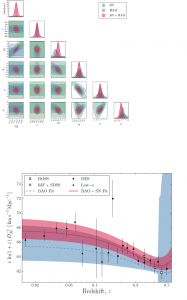Centro de Excelencia Severo Ochoa
Menu
Search

Dark Energy Survey (DES) has released 8 papers related to its first cosmology results using Type Ia supernovae. Studying these objects led to the discovery of the effects of dark energy 20 years ago. The new papers can be read at: https://des.ncsa.illinois.edu/releases/sn
Researchers from Centro de Investigaciones Energéticas, MedioAmbientales y Tecnológicas (CIEMAT), Institut de Ciències de l'Espai (IEEC-CSIC), Institut de Física d'Altes Energies (IFAE) and Instituto de Física Teórica (UAM-CSIC) have participated in obtaining these results.
They describe the first public data release of the Dark Energy Survey Supernova Program, DES-SN3YR, consisting of data products used to compute the cosmological result from the first 3 years of spectroscopically classified supernovae. They provide filter transmissions, photometry and SN+Host metadata, bias corrections, best fit distances, measurement uncertainties, full systematic covariance matrix, and CosmoMC inputs & chains. DES-SN3YR is based on a set of 207 Type Ia SNe from DES and 122 SNe Ia from external Low-z SN Ia samples. This work builds on a series of companion analyses on the DES-SN sample covering SN Ia discovery, spectroscopic selection, photometry, calibration, selection bias corrections, and evaluation of systematic uncertainties.
They present an improved measurement of the Hubble Constant (H0) using the 'inverse distance ladder' method, which adds the information from 207 Type Ia supernovae (SNe Ia) from the Dark Energy Survey (DES) at redshift 0.018 < z < 0.85 to existing distance measurements of 122 low redshift (z < 0.07) SNe Ia (Low-z) and measurements of Baryon Acoustic Oscillations (BAOs). Whereas traditional measurements of H0 with SNe Ia use a distance ladder of parallax and Cepheid variable stars, the inverse distance ladder relies on absolute distance measurements from the BAOs to calibrate the intrinsic magnitude of the SNe Ia. They find H0 = 67.77 +/- 1.30 km s-1 Mpc-1 (statistical and systematic uncertainties, 68% confidence). Their measurement makes minimal assumptions about the underlying cosmological model, and their analysis was blinded to reduce confirmation bias. They examine possible systematic uncertainties and all are presently below the statistical uncertainties. Their H0 value is consistent with estimates derived from the Cosmic Microwave Background assuming a LCDM universe (Planck Collaboration et al. 2018).
To follow the paper in arXiv see: http://arxiv.org/abs/1811.02376
Social media